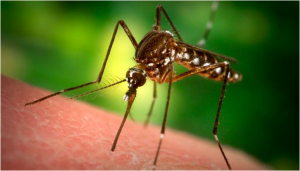Mosquito control
 Azolla can be used to control mosquitoes because a thick azolla mat on the water surface helps to prevent breeding and adult emergence.
Azolla can be used to control mosquitoes because a thick azolla mat on the water surface helps to prevent breeding and adult emergence.
In a survey of pools, ponds, wells, rice fields, and drains, Ansari & Sharma (1991) found that breeding by Anopheles was almost completely suppressed in water bodies that were covered with azolla.
Laboratory experiments by Rajendran & Reuben (1991) have also shown that immature mosquito populations of Anopheles subpictus, Culex pseudovishnui and C. tritaeniorhynchus were reduced by a 90% cover of Azolla microphylla, and that Azolla pinnata greatly reduced the oviposition and adult emergence of Culex quinquefasciatus and Anopheles culicifacies.
See this page for more details.
Weed control
Azolla can be used to control weeds. Krock et al. (1991) found that an azolla cover significantly reduced the total amount of weeds, particularly the predominant weed Monochoria vaginalis. The azolla cover reduced light intensity by about 90%, reducing photosynthesis in the floodwater and thus reducing oxygen concentration of the water by more than 50%.
Besides reducing light intensity, an azolla cover alters light quality, the green leaves having a filter effect that increases the relative amount of infrared rays which reduces the germination of light-sensitive seeds.
Azolla’s reduction of methane emission from rice fields
Radha Prasana and a group of colleagues at various institutes in India have shown that methane production from rice growth is inhibited by the presence of azolla. This is relevant to reducing greenhouse gases (Prasana et al., 2002).
They investigated the role of cyanobacteria and azolla in methane production and oxidation in laboratory simulation experiments using soil samples from rice fields. All seven cyanobacterial strains that were tested and azolla produced a significant decrease in the headspace concentration of methane in flooded soil, incubated under light.
Synechocystis sp. was the most effective in retarding methane concentration by 10 to 20 times that seen in controls without cyanobacteria. The decrease in the headspace concentration of methane was negligible in non-sterile soil samples, inoculated with Synechocystis sp. and then incubated under dark conditions.
Moist soil cores (0–5 cm depth), collected from rice fields that had been treated with urea in combination with a cyanobacterial mixture, Azolla microphylla, or cyanobacterial mixture plus Azolla microphylla, effected distinctly more rapid decrease in the headspace concentration of methane added at 200 μl–1 than did the soil cores from plots treated with urea alone (30, 60, 90 and 120 kg N ha–1), irrespective of the rate of chemical nitrogen applied to rice fields.
Soil cores from plots treated with urea alone at 60, 90 and 120 kg N ha–1 oxidized methane more rapidly than did the core samples from plots treated with urea alone at 30 kg N ha–1.
They concluded that both cyanobacteria and Azolla microphylla, applied to flood water, can play a major role in the mitigation of methane emission from rice fields through enhanced methane oxidation.
Removal of diesel contaminants
Cohen et al. (2002) have shown that azolla has the potential to biodegrade and remove diesel contaminants from soil and water.
The team of scientists, based in Japan and the USA, investigated the use of Azolla pinnata, as well as Pistia striatiotes and Salvinia molesta in fuel-contaminated environments. Soil was contaminated with diesel, flooded and inoculated with azolla. After 16 weeks the azolla plants had died and were surrounded by bacterial flocs.
Cohen et al. (2002) found that the amount of diesel had been halved and that xylenes and ethylbenzenes were 50 to 100 times lower than before the azolla application. They concluded that the diesel degradation was due to the release of bacteria (bioaugmentation) and physiochemical improvement of the soil and water (biostimulation).
Removal of heavy metal pollutants from water
Azolla can be used to purify water polluted by metals.
Jain et al. (1989) found that Azolla pinnata and Lemna minor (duckweed) removed the heavy metals iron and copper from polluted water when the metals are present at low concentrations. They concluded that effluent containing metal pollutants in low concentrations could be treated by passing it through ponds containing one or both of these water plants.
Saxena (1995) found that a mixed culture of Lemna and azolla in the ratio of 2:1 was able to purify highly polluted effluent from factories sufficiently for it to be used for agricultural purposes.
Azolla’s potential to purify water has potential applications for both industrial and mining operations, as well as space exploration.
Removal of gold from wastewater
Gilding generates large volumes of wastewater with residual gold, posing environmental and financial problems necessitating metal recovery.
Following earlier studies on azolla by Antunes et al. (2001) and Khosravi et al. (2005), Umali et al. (2006) found that Azolla filiculoides removed more than 98% of gold from waste water in a gold plating factory and developed a continuous flow column system that removed 100% of the gold from waste water.
Purification of wastewater
Costa et al. (1999, 2009) demonstrated azolla’s ability to grow well in partially treated domestic wastewater and in effluents from wastewater stabilization ponds despite the high ammonium content of the medium.
These results confirm azolla’s use as a biofilter for the removal of both phosphorus and nitrogen. Furthermore, azolla is able to do when nitrogen becomes a limiting growth factor, which is sometimes the case with urban wastewater treated by conventional processes. This illustrates the advantage of using azolla instead of other small macrophytes (Lemnaceae) which are also used to upgrade wastewater quality.
As pointed out by Costa et al. (2009), the azolla biomass resulting from the purification process can also be used as a biofertiliser, which decreases the cost of phosphorus removal in wastewaters, of particular benefit to small communities.
